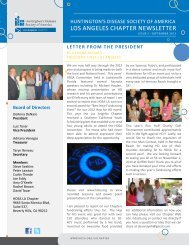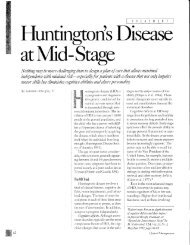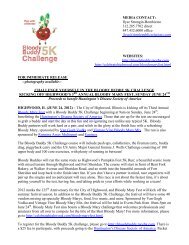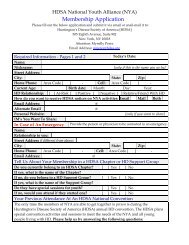Understanding Behavior in HD.final.8-18-05 - Huntington's Disease ...
Understanding Behavior in HD.final.8-18-05 - Huntington's Disease ...
Understanding Behavior in HD.final.8-18-05 - Huntington's Disease ...
Create successful ePaper yourself
Turn your PDF publications into a flip-book with our unique Google optimized e-Paper software.
2<br />
Often, it is helpful for caregivers to try to understand why the person with <strong>HD</strong> is act<strong>in</strong>g <strong>in</strong> a particular<br />
way. If caregivers can determ<strong>in</strong>e what might be caus<strong>in</strong>g or trigger<strong>in</strong>g the unwanted behavior, it becomes easier<br />
to cope with the behavior and, sometimes, to prevent the difficult behavior from recurr<strong>in</strong>g. Listed below are<br />
some possible reasons for behavioral difficulties <strong>in</strong> <strong>HD</strong>. A specific behavior may be the result of one or all of<br />
these reasons.<br />
HOW DOES THE BRAIN CONTRIBUTE TO<br />
BEHAVIOR CHANGES IN <strong>HD</strong>?<br />
UNDERSTANDING ANATOMY AND RELATED BEHAVIORS<br />
Different parts of the bra<strong>in</strong> are responsible for different aspects of our behavior. Below is a picture of a<br />
bra<strong>in</strong> show<strong>in</strong>g some of these different general responsibilities.<br />
For <strong>in</strong>stance, the occipital lobes conta<strong>in</strong><br />
the cells which help us to see. These cells tell<br />
us the shape, color and movement of th<strong>in</strong>gs<br />
we see. The neighbor<strong>in</strong>g parietal lobes tell us<br />
the spatial location of th<strong>in</strong>gs that we see,<br />
hear or touch, just like a map tells us the<br />
location of countries, cities and roads. The<br />
temporal lobes are very important for our<br />
memory, conta<strong>in</strong><strong>in</strong>g cells that help us<br />
remember a face, a name or an event that has taken place. The frontal lobes make up the largest area of the<br />
bra<strong>in</strong> and conta<strong>in</strong> the highest levels of our behaviors. The frontal lobe area of the bra<strong>in</strong> is often considered the<br />
“boss,” or chief executive officer (CEO), of the rest of the bra<strong>in</strong>. The follow<strong>in</strong>g list <strong>in</strong>cludes executive functions<br />
of the frontal lobes.<br />
• Organiz<strong>in</strong>g<br />
• Establish<strong>in</strong>g the priority of various events<br />
• Controll<strong>in</strong>g impulses<br />
• Monitor<strong>in</strong>g self-awareness<br />
• Beg<strong>in</strong>n<strong>in</strong>g and end<strong>in</strong>g activities<br />
• Creative th<strong>in</strong>k<strong>in</strong>g<br />
• Problem-solv<strong>in</strong>g<br />
Although the effects of the <strong>HD</strong> gene are not fully understood, the primary site of known pathology is the<br />
caudate nucleus <strong>in</strong> the bra<strong>in</strong>, where the greatest number of bra<strong>in</strong> cells die because of <strong>HD</strong>. We cannot see the<br />
caudate from our picture of the bra<strong>in</strong> above because it is located deep with<strong>in</strong> the bra<strong>in</strong>. Let’s take a closer look

















